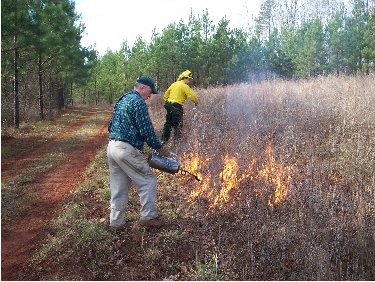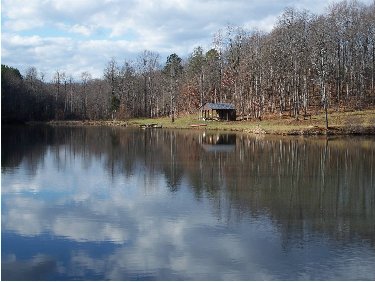As I mentioned in earlier posts, one of the things I get to do as VFA Tree Farm communications director is to interview the outstanding tree farmer of the year. I learn a lot from these guys and I like to share a part of it with others through the write ups. I met this year’s winner at his farm near Hardy VA a couple days ago. This is my draft article for the “Virginia Forests” magazine.
Tom and Sallie Newbill are bucking the trend and doing what so many small forest owners dream of doing. While fragmentation is a big challenge of today’s Virginian forests as farm and timber lands are divided into smaller parcels, some almost too small for proper management, the Newbills have been bringing land together into a bigger well-managed unit. They started to assemble the pieces that became Montmorenci Tree Farms in 1967 and over the next decades built their inventory of land to include 1190 acres in Franklin County, Virginia and Halifax County NC. Their home place unites three adjoining farms in Franklin County, VA plus two others are nearby. The North Carolina place comes through Sallie’s family. That is also where the name Montmorenci originates. In 1772, Sallie’s mother’s family received a land grant in North Carolina from the King of England, in this case George III, and they called their estate Montmorenci. Sallie and Tom revived the name for their farms.
Tom Newbill was not always in the forestry business. After graduating from Virginia Tech with a degree in engineering, he took a job with Westvaco and later worked for IBM and as a principal in a computer services company in Atlanta, Georgia, where the family lived between 1966 and 1996. Sallie taught school and later spent ten years as a State Senator in the Georgia state legislature. But Tom felt the pull of the forests of home. He grew up in Franklin County around forestry operations. His uncle ran the local saw mill and Tom had a long and natural connection with forestry so he always appreciated the stable value of land and timber.
When the Newbills had opportunities to invest for their future, timberland seemed a natural choice and the woods of home a natural location. Tom was returning to his deep roots in Franklin County. His mother was a long time school teacher in the region and it seemed like half the people of the county had been her pupils. The Newbills bought their first forest land in 1968 and eventually brought together what had been five separate farms. Both Sallie and Tom inherited land from their parents, and later bought out their siblings. Each farm had its own story and its own family cemetery, where some of the biggest trees still grow. Tom and Sallie are very respectful of the cemeteries. Family members still occasionally visit, but as the years go by the visits are becoming less frequent.
Below – controlled burning is an essential tool of forestry and wildlife management. Virginia pine forests are fire dependent. Native Americans burned forests every couple of years. Small controlled fires stimulate growth and help avoid the large disasterous forest fires that result from too much fire supression.

The Newbills use some of the best forestry practices on their acreage, including planting the latest generation of trees (Tom even has a few third generation loblolly pines on his land), controlled burning, proper thinning, and use of modern chemical treatment; but he does not take the credit for understanding and employing all these techniques. Tom says that Jim Ebbert, who recently retired from the Virginia Department of Forestry, was for most practical purposes his land manager. Tom joked that he wondered how Jim could accomplish the other parts of his job while doing so much for Montmorenci Tree Farms. Another big help was Westvaco’s Rob Bell, who ran the local Cooperative Farms Management (CFM) program. Among other things, Rob helped with details of timber sales, something that the DOF does not do. Today Tom gets professional advice from both MeadWestvaco and Travis Rivers at the Virginia Department of Forestry.
Travis nominated Tom Newbill as this year’s outstanding tree farmer and says that working with someone like Tom is great for everybody involved. The Commonwealth of Virginia has a strong interest in helping responsible tree farmers like Tom and Sallie improve their land and produce timber while protecting the soils and waters of the Old Dominion. Partnerships like this make it all possible. In addition to timber production, about a quarter of Montmorenci Tree Farm’s land is devoted to stream management zones, wildlife plots, and cropland rented to a local dairy farmer. Tom actively manages the wildlife plots and turkey, deer and quail abound on the land. Water and wildlife resources are further enhanced by a five acre lake he built on the home tract. The lake supports bluegill and largemouth bass. Ducks and geese use the waters. Tom says that one particular pair of geese had been returning to his lake for six years to raise their families of goslings. In 2006, six goslings grew to maturity.
Below – Tom’s lake. I hope to make a similar one on my land.

The advantages of managing as much acreage as the Newbills’ own is the diversity it allows. Over the years, timber has been harvested from all Montmorenci tracts, mostly clear cuts, and currently the oldest plantation was established in 1978. The youngest is from 2000. This gives Tom a variety of harvest and management options, as one or more of the eight unique stands, plus SMZ or wildlife plots is always ready for some kind of treatment. Tom also gets a first hand, up close experience of the difference between growing pines in the mountains (Franklin County) as opposed to the tidewater (Halifax County, NC).
Tom’s observation is that loblolly pines in the mountains are about five years behind those of the tidewater, which is a significant difference. Franklin County lies on the edge of loblolly country. In fact, Tom’s farm is outside the natural range of the tree. One advantage of growing loblolly pines in the mountains is that there are very few “volunteer pines”. Tom has not had to do any pre-commercial thinning and when properly treated there is little competition from hardwoods or weeds. The southern pine beetle is also somewhat less of a problem in this cooler and higher environment. In the tidewater, well within the natural loblolly range, volunteer pines fill in much more profusely, as do weeds. On the other hand, properly managed pines grow significantly faster. Beyond that, the flatter topography makes thinning and other treatment operations much easier. Another more general difference between tree farming on the tidewater and in the mountains is species composition. The mountains provide good natural regeneration of poplar and there is a good local market for it.
Tom has been a member of the Virginia Forestry Association since 1974. Whether it is in the mountains or the tidewater, Tom Newbill and his family are doing an outstanding job as tree farmers. They are well and truly achieving what tree farmers strive to achieve. They are producing timber while at the same time protecting water and wildlife resources and providing places for recreation. The Virginia Tree Farm Committee congratulates the Newbill family on a job well done and a job they continue to do.
